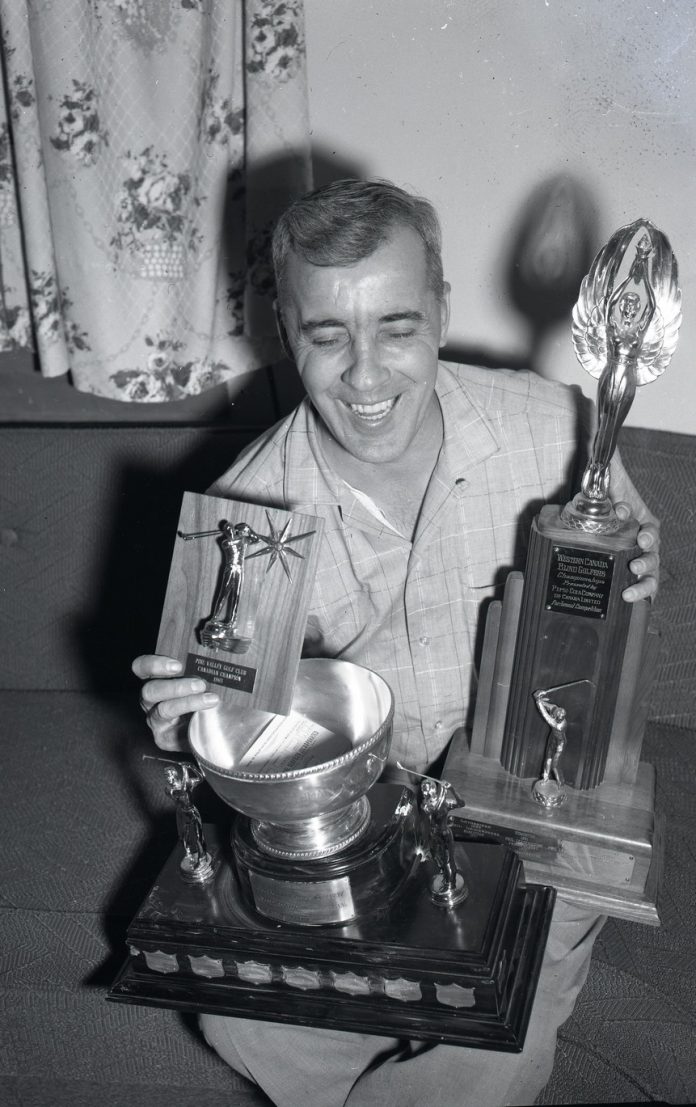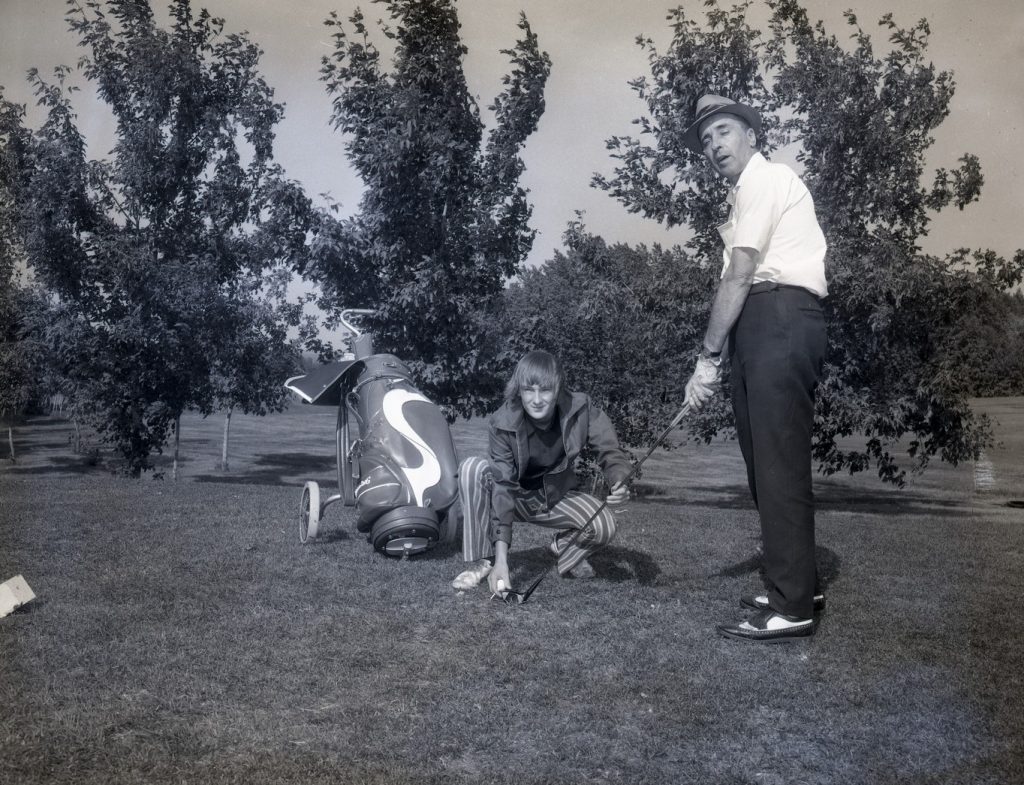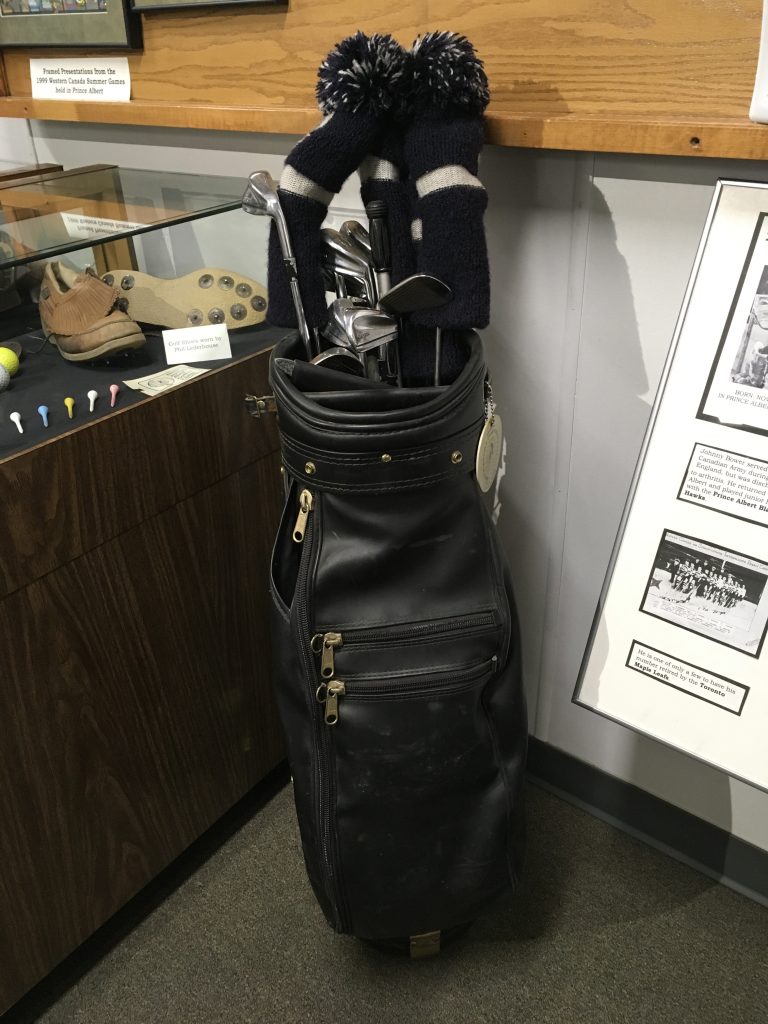
Were you to ask me what my favourite artefact is on the upper floor of the Prince Albert Historical Museum, I would very probably reply “the golf clubs”.
People who know me would be surprised, as I am anything but a golf enthusiast. I did try golfing when I was younger (much younger!), but I did not find much enjoyment in batting a little white ball around that green grass. That was likely because whenever I hit the ball, it tended to land anywhere but on those green fairways.
So, why would I focus on a set of golf clubs as my favourite exhibit? It isn’t the clubs which attract me, but the man who wielded those clubs, and the places that they have been in the time he played.
Of course, I am talking about Phil Lederhouse’s golf clubs, and Phil Lederhouse himself. The fact that he took up golf after he lost his eye sight, overcoming an obstacle that would have resulted in most of us forgetting any desire to try playing the game of golf, is simply one of many reasons that I am attracted to his story.
Nor is it the fact that Lederhouse developed into such a successful golfer. I think that his sense of humour is probably the major attraction for me. When challenged by Bob Hope to a match as a charity fund raiser, Lederhouse promptly agreed, suggesting that Hope choose the course while he chose the time. Hope agreed, and chose the noted California course, Pebble Beach. Lederhouse then determined that the match would be played at midnight, a time which would not be a problem to him, but would definitely be difficult for Hope!
When asked whether it was hard for him to hit the golf ball, he replied that he could hit it easily enough. The problem came to finding it afterwards.

Lederhouse lost his eye sight when he was 19 years of age. In order to make a living, he cut firewood in the bush north of the stately river which flows through our city. During the Second World War, Lederhouse gained employment with M & C Aviation. A story published at the time by the Prince Albert Daily Herald was headlined “Blind Man Excells in Tricky Operation, Helps Win War With Aircraft Industry”. His task was one which few sighted people would have been able to accomplish with such success. He sorted tens of thousands of screws – forty different shapes, sizes, and head types – making so few mistakes that it was considered negligible.
While attending the CNIB Rehabilitation Centre in Saskatoon in the 1940s, he met his future wife, Ruby, who was also blind. Ruby had read an article about blind golf in a magazine and encouraged Lederhouse to try the sport. So it was that Lederhouse and his friend, Hubert Cooke, Prince Albert’s golf pro, went out on a Sunday morning to one of the tee boxes at the local golf course, and Lederhouse began hitting his first balls. Six months later, and Lederhouse, with his coach Hubert Cooke, travelled to Hamilton, Ontario, where he won the Canadian Blind Golfers championship. Three months later, and Lederhouse, who was a natural when it came to golf, placed third in the International Blind Golfers Championship.
Even though Lederhouse was a natural, he needed help in order to achieve his success on the golf course. He was able to set up and swing the club on his own, but had to have the guidance of a coach to ensure that he was able to hit the ball in the right direction. In addition to Cooke, Lederhouse had assistance from among others, Gord Coombs, Jimmy McCubben, Tom Sherman, Danny Jutras, Keith Stieb, and his nephew Dave Leaderhouse. They would help him to line up in the right direction, gauge the wind, as well as the elevation. When it came to putting, Lederhouse and his coach together would pace off the distance to the cup before the coach would set up the stroke.
From his first tournament until his death in 1991, Lederhouse dominated in every tournament in which he played. He won twenty Saskatchewan titles, fifteen Western Canadian titles, five Canadian championships, the British Open Blind Golf tournament, and was runner-up in two world tournaments. His favourite accomplishment, aside from his family, was likely his hole in one, which he managed at the age of 74.
His success made Lederhouse a celebrity of sorts. In addition to the previously mentioned Bob Hope, he met entertainment icons such as Jack Parr and Ed Sullivan, golfer Jack Nicklaus, and Mr. Hockey himself, Gordie Howe.

Lederhouse was inducted into the Saskatchewan Sports Hall of Fame, the Prince Albert Sports Hall of Fame, and was named Prince Albert’s Athlete of the Year in 1990.
Lederhouse married Ruby in 1952, and raised three children, Grant, Bryan, and Lynda, who all helped them run the hospital canteens in the old Victoria Hospital and the Holy Family Hospital. When the current Victoria Hospital opened, the Lederhouse family ran the canteen there until the canteen was closed at the end of 2013.
In addition to his prowess on the golf course, Lederhouse was able to play both the guitar and the piano by ear.
Lederhouse died of a heart attack in 1991.
The Lederhouse family have donated his clubs, spiked shoes, and golf glove to the Historical Society, and they are on display at the Historical Museum, 10 River Street East. Whether you are a golf afficionado or not, I encourage you to visit the Museum to view them and to spend some time imagining what they could say if only they could talk.
fgpayton@sasktel.net

